Are You Doing Your Bit?
December 15, 2010
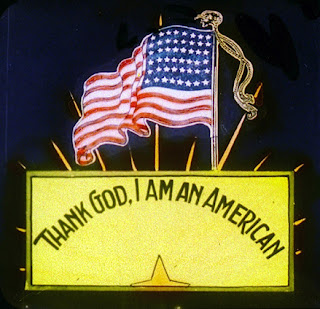
Lantern slides in motion picture venues served a multitude of purposes - they touted products, advertised local merchants, instructed audience behavior (don't spit on the floor!), led them in song, and promoted upcoming programs.
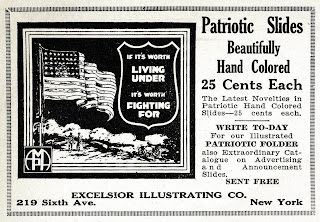
During wartime slides also served as a means to promote (or demonstrate) patriotism and to support the the propaganda needs of the government.
Commercial Patriotic Slides
Slides of this variety fall into two broad categories. The first type are slides that the exhibitor themselves purchased from commercial manufacturers such as the Excelsior Illustrating Company or Novelty Slides, Inc.
These slides declared simple patriotic slogans and were typically embellished with color images of eagles, flags, soldiers presidential profiles, or other patriotic symbols. Motion picture trade magazines such as Motion Picture News and Moving Picture World featured advertisements for these types of slides which could be purchased for 15¢ to 25¢ each.
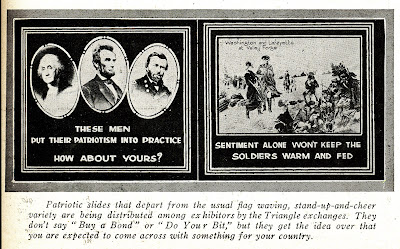
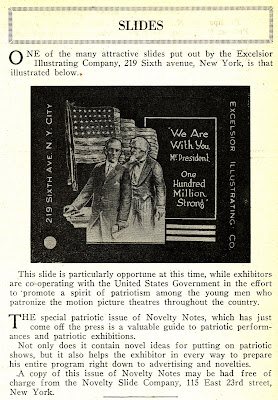
Within the cinema, these patriotic appeals generally led off the program.
In her book Reel Patriotism: The Movies and World War I, Leslie Midkiff DeBauche describes the scene:
"Once the houselights dimmed and the movie-goers' attention was directed to the screen, the theater manager had a final opportunity to promote his theater by striking the patriotic chord. [...] The Excelsior Illustrating Company of New York sold "a few of the other beautifully handcolored patriotic slides, 25 cents.' Or exhibitors could make their own slides. Joseph Yeager, owner of a chain of theaters in Raton, New Mexico, showed slides of local mean who had enlisted. 'The [the slides] are making a hit now and he has a full set for later use should they be killed or perform some unusual service.'"
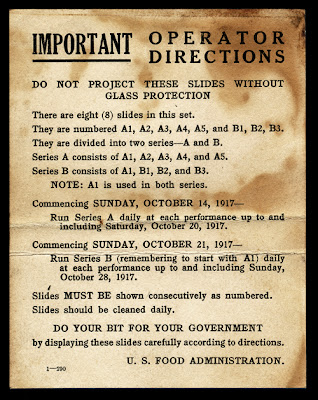
Government Issued Propaganda Slides
The second variety of wartime patriotic slide were propaganda slides provide directly from government agencies.
Slides in this category promoted enlistment into the armed services, encouraged sacrifice and volunteerism on the home front, and touted the purchase of war bonds.
These slides were often of components of coordinated multi-media campaigns which combined slides and motion pictures with printed material such as handbills and posters.
For example, the Food Administration's extensive Second Food Pledge Card Drive included a set of eight slides that were furnished to theatre owners. The dates and sequence for exhibiting these slides were specifically detailed in an instruction sheet which accompanied the slides. In addition to the slides, the campaign included newsreel films of President Woodrow Wilson and former president Herbert Hoover, and posters proclaiming "Food Will Win the War."
The campaign proved to be a great success. According to DeBauche:
"The Second Pledge Card Drive, which was designed to enlist the housewives of the nation in the Food Administration's conservation efforts, was highly successful. Ten and one-half million pledge cards were signed, and the same number of window cards were distributed. The film industry contributed to this successful outcome by visibly aligning itself with food conservation efforts. Long after the campaign ended, exhibitors displayed the colorful posters and framed certificates [...] to remind patrons of their patriotism."
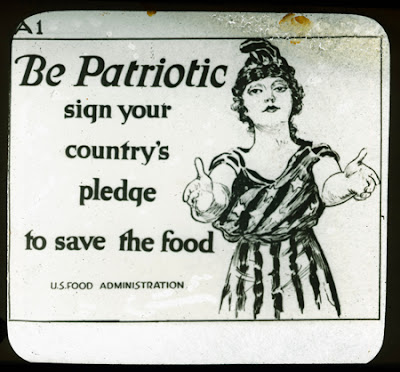
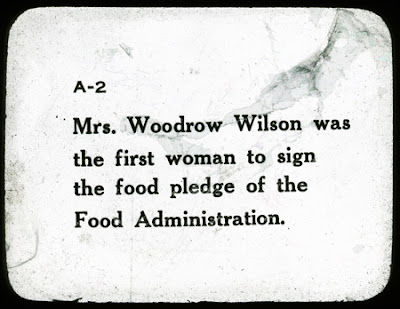
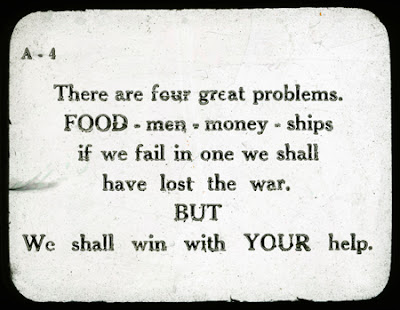
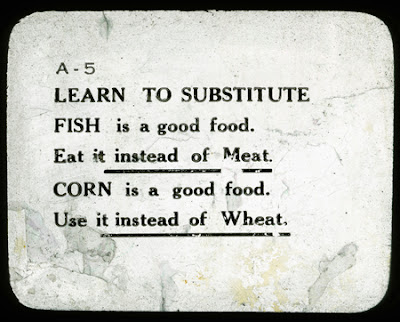
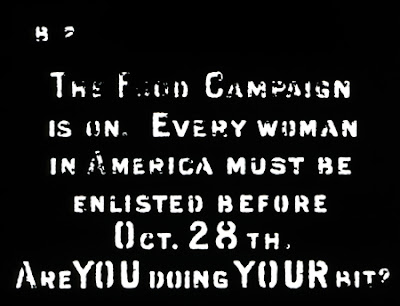
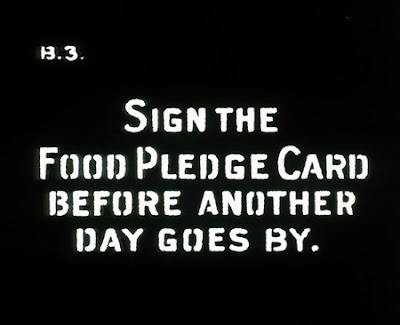
Mass Production Meets the Propaganda Slide
Government issued propaganda slides were manufactured on a grand scale. The U.S. Treasury Department created 30,000 slides supporting the first Liberty Loan drive, and manufactured 17,500 more sets of three slides per set for the second bond drive.
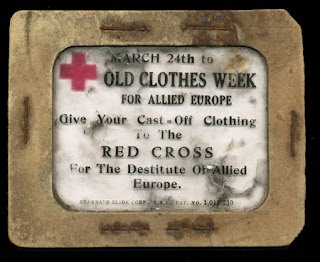
Though these slides were created in great quantity, they were also designed with an extremely short shelf-life in mind. They were intended to exhibited over a very specific time during the campaign and then discarded afterwards.
These considerations clearly manifested in manufacturing processes that appear to be unique to government produced slides - processes which obviously empasize quantity over quality.
Unlike commercially produced slides of the era, these government-issued slides were not manufactured using photographic plates. Instead, they were produced by printing the message onto cellophane or stamping it into metal.
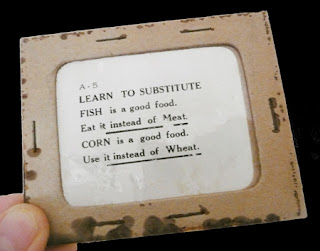
Cellophane based slides consisted of simple black type printed on an thin cellophane pane. The cellophane was then supported by an equally flimsy cardboard frame and stapled at the edges.
To a certain extent, this cardboard frame construction predicts the more refined cardboard frame manufacturing process that the industry adopted in 1924 (see Anatomy of a Slide), but there are also significant differences.
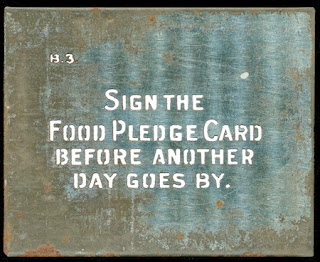
The most obvious is that the image itself is printed on a press instead of screened or developed photographically and that the transparent material is flimsy cellophane instead of glass.
The other less obvious difference is that the frame consists of two separate pieces of cardboard stapled together, which differs from the later 1924 process which required a tri-fold arrangement in order to create a space within the frame to secure the glass element.
More interesting (and certainly more durable!) than the cellophane process are slides that that were simply stencil-cut from metal sheets.
These slides (I suppose they still fit that definition) have the letters simply punched out from the material.
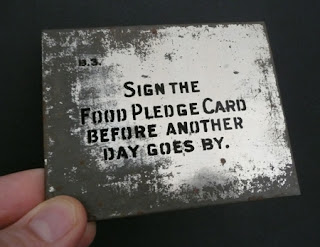
The resulting image is certainly military looking. I suppose the good news is that breakage was never a concern.
In executing these campaigns, R.C. Maxwell, the head of the U.S. Education Department complained about the "ordinary" quality of the slides and films.
Clearly he had a point.
Pledge Drive slides courtesy of Niles Essanay Silent Film Museum.
